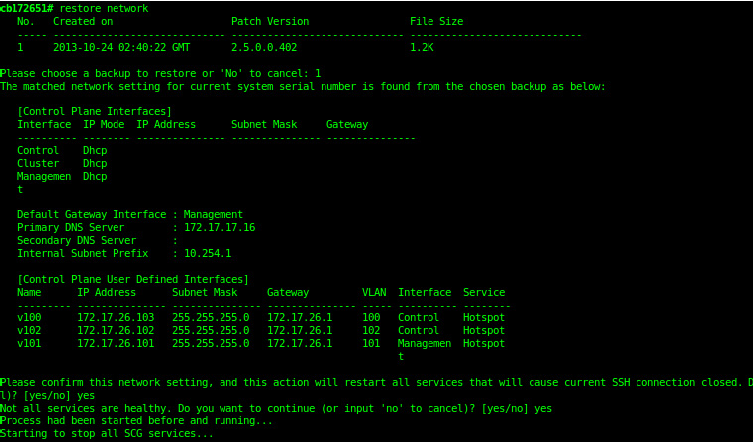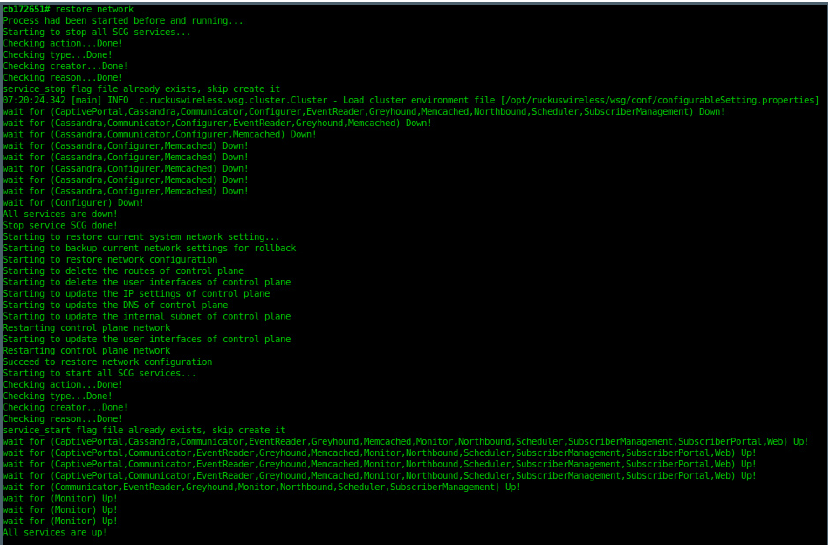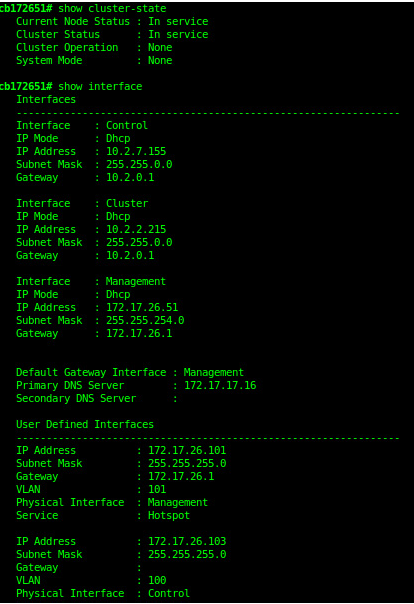Before you continue, take note of the following limitations with restoring a backup
file of the controller network configuration from an FTP server:
- Only release 2.1 and later support restoring from an FTP server.
- In this current release, restoring the entire cluster from an FTP server is unsupported.
The restore process must be performed on one node at a time.
- Restoring from an FTP server can only be performed using the
CLI.
 | CAUTION Restoring a backup file to the controller
requires restarting all of the controller services. |
Follow these steps to restore a backup file of the controller's network configuration that
you previously uploaded to an FTP back to the controller.
-
Log on to the controller from the CLI. For more information, see
the corresponding Command Line Interface Reference Guide for your controller
platform.
-
At the prompt, enter en to enable privileged mode.
Figure 138
Enable privileged mode
-
Enter show cluster-state to display the statuses of the node and the cluster.
Before continuing to the next step, verify that both the node and the cluster are in
service.
Figure 139
Verify that both the node and the cluster are in service
-
Enter the following command to log on to the FTP server and check for available backup
files that can be copied to the controller:
copy <ftp-url> backup-network
-
If multiple backup files exist on the FTP server, the CLI prompts
you to select the number that corresponds to the file that you want to copy back to the
controller.
If a single backup file exists, the CLI prompts you to confirm
that you want to copy the existing backup file to the controller.
When the controller finishes copying the selected backup file from the FTP server back
to the controller, the following message appears: Succeed to copy the chosen file
from the remote FTP server
-
Enter show backup-network to verify that the backup file was copied
back to the controller successfully.
Figure 140
Verify that the backup file was copied to the controller successfully
-
Run restore network to start restoring the contents of the backup file to the current
controller.
The CLI displays a list of backup files, and then prompts you to
select the backup file that you want to restore to the controller.
-
Enter the number that corresponds to the backup file that you want to restore.
Figure 141
Enter the number that corresponds to the backup file that you want to
restore
The CLI displays the network configuration that the selected
backup file contains.
If the serial number of the current controller matches the serial number contained in
one of the backup files, the CLI automatically selects the backup
file to restore and displays the network configuration that it contains.
-
Type yes to confirm that you want to restore the selected backup
file. The controller starts the restore process and performs the following steps:
-
Stop all services.
-
Back up the current network configuration.
This will enable the controller to roll back to the current configuration, in case
there is an issue with the restore process.
-
Clean up the current network configuration.
The controller deletes its previous network configuration, including static routes,
name server, user defined interfaces, etc.
-
Restore the network configuration contained in the selected backup file.
-
Restart all services.
When the restore process is complete, the following message appears on the CLI:
All services are up!
Figure 142
The controller performs several steps to restore the backup file
-
Do the following to verify that the restore process was completed successfully:
-
Run show cluster-state to verify that the node and the cluster are back in
service.
-
Run show interface to verify that all of the network configuration settings have
been restored.
Figure 143
Verify that the node and cluster are back in service and that the network
configuration has been restored successfully
You have completed importing and applying the network configuration backup from the FTP
server to the controller.
 CAUTIONRestoring a backup file to the controller requires restarting all of the controller services.
CAUTIONRestoring a backup file to the controller requires restarting all of the controller services.





